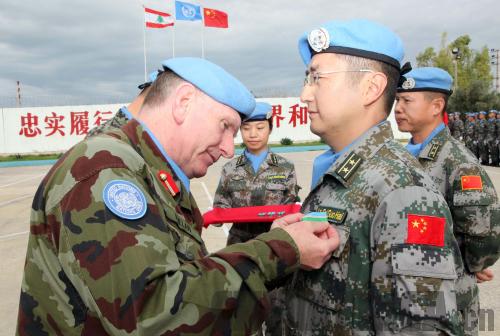|
|

|
|
Deputy Force Commander of the United Nations Interim Force in Lebanon, Brig Gen Patrick Phelan presents the UN Peace Medal of Honor to Chinese peacekeepers in South Sudan for their outsanding contribution on December 5, 2012 (LIU SHUN) |
On April 16, the Chinese Government published a national defense white paper, The Diversified Employment of China's Armed Forces. China's armed forces comprise the People's Liberation Army (PLA), the People's Armed Police Force (PAPF) and the nation's militia.
The white paper, the eighth of its kind issued by the Chinese Government since 1998, describes the strategic policy principles governing China's armed forces. It highlights the strategic importance of the armed forces in maintaining national security and supporting the country's peaceful development. The white paper emphasizes China's pursuit of comprehensive, common and cooperative security, and also discusses the country's experiences and contributions in this aspect.
In addition to notes concerning China's security situation and the development of China's armed forces, the white paper details the policies and principles directing the duties of China's armed forces and the PLA's combat readiness, as well as the PLA's efforts to safeguard the country's maritime rights and interests, overseas interests and international sea lines of communication.
The paper also reveals for the first time the actual number of army, navy and air force servicemen, as well as the designations of China's army combined corps and main missile lineup, representing remarkable progress toward military transparency.
The preface of the white paper states, "China has made an unshakable national commitment and strategic choice to take the road of peaceful development. China unswervingly pursues an independent foreign policy of peace and a national defense policy that is defensive in nature," and "China will never seek hegemony or behave in a hegemonic manner, nor will it engage in military expansion."
Over the years, the PLA has proactively and steadily pushed forward reforms in line with the requirements of its missions and the building of a modern military. The goal of deepening military reforms with Chinese characteristics is to make the armed forces lean, unified, multi-functional and efficient under modern conditions.
In response to China's core security needs, the armed forces' focus is on maintaining peace, containing crises and winning wars. They constantly place above all else the protection of China's national sovereignty and security as well as the interests of the Chinese people.
The new white paper includes a summary of the fundamental policies and principles of China's armed forces, and the duties that the armed forces seek to fulfill. These include: safeguarding national sovereignty and security, and supporting the country's peaceful development; winning local wars and intensifying military preparedness; building comprehensive security and effectively conducting military operations other than war; deepening security cooperation and fulfilling international obligations; and acting in accordance with all relevant laws and policies.
With over 22,000 km of land borders, China has many neighbors and an extremely complicated security environment. Maintaining constant combat readiness to safeguard the security of the country's land and maritime borders as well as its airspace is an important part of managing various security threats and accomplishing diverse military tasks.
Scenario-based exercises and drills are the basic means by which the PLA conducts military training and raises its combat capabilities. The white paper's section on scenario-based exercises and drills briefly introduces these practices along with the navy's blue water training.
The white paper also has a section on safeguarding maritime rights and interests. As China has over 18,000 km of coastline and hundreds of islands, maritime safety is a major national concern. In combination with its routine combat readiness activities, the PLA Navy provides security support for China's maritime law enforcement, fisheries, and oil and gas exploitation.
|